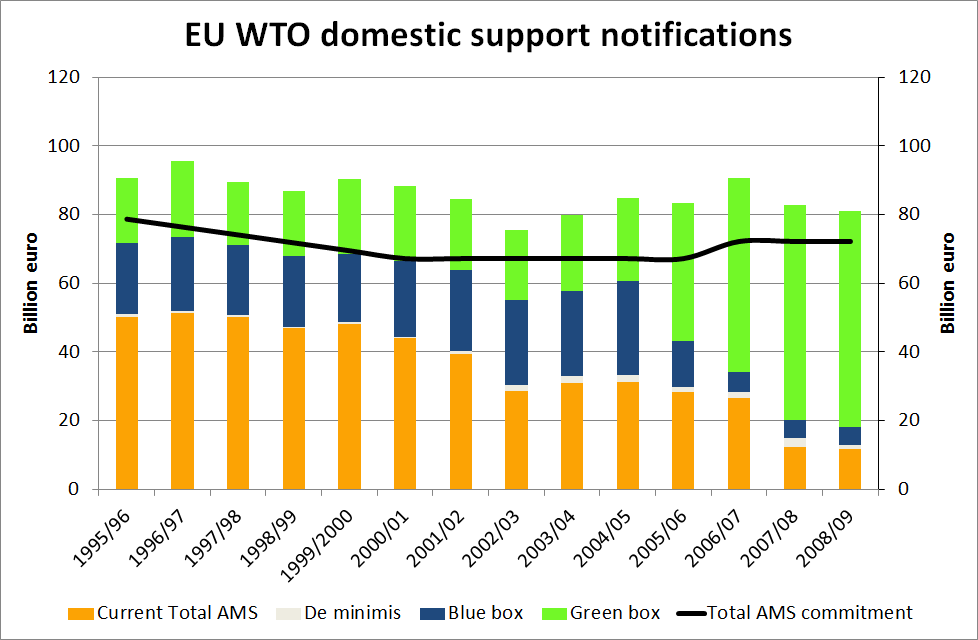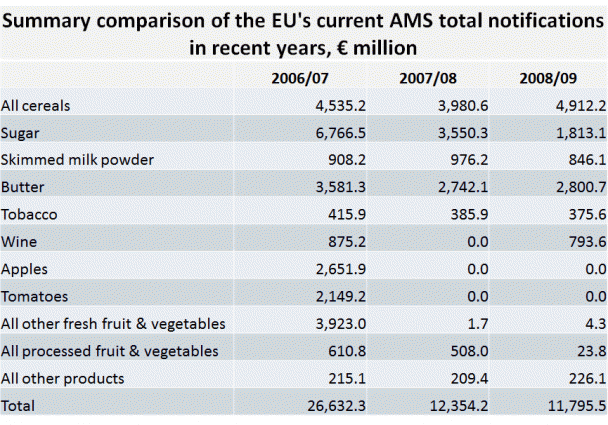The EU has just submitted its domestic support notification to the WTO for the year 2008/09 (hat tip to LB) and this year there are no surprises. Total support (using the WTO definition) was a shade over €80 billion, but the value of its trade-distorting support (the so-called ‘amber box’, given by its current total Aggregate Measure of Support) fell to its lowest level ever, at just under €12 billion.
In that year, the EU used just over 16% of its Total AMS commitment (its bound ceiling) of €72.2 billion. In other words, the EU could have reduced its AMS commitment by over 80% in that year and would still have fulfilled its WTO amber box obligation.
The AMS includes three main categories of support: direct payments that do not fall under the green or blue boxes as non-exempt direct payments; market price support for products for which an administered price exists; and an equivalent measure of support for those products where the domestic market is supported but where no obvious administered price exists. The equivalent measure of support was mainly used for fruits and vegetables, where support is given on a periodic basis.
The figure above shows the trend in EU domestic support by category since notifications began in 1995/96 (click on the figure to enlarge). At the outset, the amber box, consisting mainly of market price support and coupled direct payments, amounted to around €50 billion with another €20 billion consisting of production-limited direct payments sheltered in the blue box. A further €20 billion was accounted for by green box support, consisting of payments deemed not to be or to be only minimally trade-distorting such as general services to agriculture, agri-environment payments, investment aids and decoupled income support.
Two recent changes since 2004/05 in the distribution of support between the boxes are worth highlighting. The first is the conversion of blue box support into green box support as a result of the decoupling of direct payments after 2005. The second, equally striking, is the drop in amber box support in 2007/08 (discussed in a previous post).
Changes in measuring support to the fruit and vegetables sector
This is due to the fact that the EU no longer includes an ‘equivalent measure of support’ for fruits and vegetables. In the past, support to fruits and vegetables was calculated as the support provided through the entry price system, which sets the minimum import price for imported fruits and vegetables. Now, the EU has started to calculate it based on the budgetary cost of market withdrawals. Most of this falls under the de minimis heading and so is no longer recorded.
The EU has justified this change in the WTO Committee on Agriculture as follows (see also the discussion in the earlier post):
The primary measure providing support for fruit and vegetables prior to the 2007 reform was not the entry price system (EPS). The EPS is a form of border protection in the realm of the market access pillar. It was not the existence of the EPS as such that implied the calculation of a price gap for the fruit and vegetables sector. Rather, this price gap calculation resulted from the existence of an, albeit rudimentary, price support instrument in which the entry prices only served as a proxy for the applied administered price, as per paragraph 2 of Annex 4 of the Agreement on Agriculture. This price support instrument was abandoned in the 2007 reform.
The suggestion that the 2007 reform resulted in the abandonment of a price support instrument that previously operated in the sector is not wholly convincing. The only price support instrument (apart from the entry price system) that operated in the fruits and vegetables sector prior to the 2007 reform was the market withdrawal system.
Buying-in prices for fruits and vegetables were abandoned in the previous reform in 1996. Instead, the EU made payments to producer organisations for ad hoc withdrawals, in order to reduce excess supply on the market. To avoid excessive withdrawals, limits were set in the 1996 reform on the volume of products eligible for support (there was no limit before), in terms of the volume of marketed production of a producer organisation. The withdrawal compensation was also reduced and producers themselves were required to bear much of the costs. As a result, use of the withdrawal mechanism decreased dramatically following the 1996 reforms.
In the 2007 reform, there was no substantive change to these arrangements. Market withdrawals and green harvesting/non-harvesting of crops continue as the market intervention mechanisms to support fruit and vegetable producer prices. Implementation of these instruments remains the responsibility of producer organizations, with 50% co-financing by the Community and a budget limited to 0.5% of the value of the marketed production by each producer organization.
The Commissions’s argument is that the support that still existed prior to the 2007 reform was a Community compensation for withdrawals that constituted, because of the way in which it was implemented, a survival of the previous public withdrawal system. It argues that this type of support was abolished as a result of the reform, and so it is now justified to measure support in the fruits and vegetables sector using budgetary outlays rather than a price gap approach.
Changing composition of AMS support
Although the AMS totals for 2007/08 and 2008/09 are similar, there are changes in the composition of this support. There has been a sharp fall in the AMS in the sugar sector as a result of the implementation of the 2006 sugar regime reform which substantially reduced the applied administrative price used for this calculation.
This decrease in the sugar AMS has been offset by increases in the cereals AMS (due to the excellent cereal harvest in that year which increased the amount of production nominally eligible for support) and in the AMS for wine where support in 2008/09 did not qualify as de minimis.
The EU has also submitted a notification describing the changes in its wine regime which entered into force on 1 August 2008. Use of distillation measures will gradually be phased out by 2012 and this should reduce notified amber box support in this sector in the years to come.
A further fall in the measured AMS can also be foreseen for the 2010/11 marketing year when the intervention price for sugar is abolished.
Prospects for the EU’s AMS after 2013
In its post-2013 CAP legislative proposals (the single CMO regulation), the Commission is at pains to distinguish between reference prices and intervention prices, clarifying that only intervention prices for public intervention correspond to the applied administered prices for the purposes of AMS calculations in the WTO Agreement on Agriculture (i.e. price gap support).
The products eligible for public intervention include common wheat, barley, maize, paddy rice, beef and veal, and butter and skimmed milk powder. Public intervention at a fixed price for common wheat, butter and skimmed milk powder is limited to specific quantities, after which it will operate by way of a tendering procedure to determine the maximum buying-in price. These are the arrangements currently in place so no further changes (other than dropping sugar and the changes taking place in wine) are envisaged for the market support element of the AMS calculation.
The other elements of the AMS consist of coupled direct payments and budgetary outlays for market crisis intervention which are not excluded under the de minimis rule. Further reductions in expenditure on coupled payments are expected as a result of CAP Health Check decisions already taken, and market crisis expenditures are also not expected to increase after 2013.
Thus, the downward trend in the EU’s measured AMS can be expected to continue assuming there is no challenge to the Commission’s proposed basic income payment and, more particularly, the proposed new green payment. Alan Swinbank in his recent presentation on direct payments for the European Parliament’s COMAGRI laid out some cogent reasons why the green payment, in particular, might be challenged as not meeting the criteria for decoupled income support. I will return to these arguments in a later post.
This post was written by Alan Matthews.




For lack of time, I just tell you that the wine AMS was of €793.6 million in 2008-09 so that you should not have hidden it in the “all other products” category.
Best regards
Jacques Berthelot
@ Jacques
Many thanks for spotting that error in the table which I have now corrected.